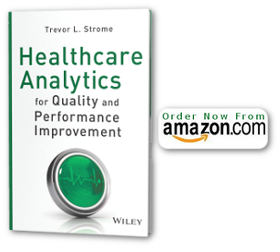 This posting is an extracted and abridged selection from my book “Healthcare Analytics for Quality and Performance Improvement”, published by John Wiley & Sons Inc., and available at Amazon.com in hardcover and e-reader formats.
This posting is an extracted and abridged selection from my book “Healthcare Analytics for Quality and Performance Improvement”, published by John Wiley & Sons Inc., and available at Amazon.com in hardcover and e-reader formats.
Analytics excellence, as it relates to healthcare quality improvement, occurs when the strategies, people, processes, and technologies are applied to improvement initiatives and positively impact the quality and performance of a healthcare organization.
In other words, being an analytical organization requires more than simply acquiring or possessing the tools and technology of analytics. Regardless of the actual analytics technologies in place, healthcare leaders, quality improvement teams, and other decision makers must actually make decisions and take actions based on the information and insight available through analytics.
Even healthcare organizations replete with the latest and most sophisticated analytical platforms may not make full use of the capabilities available. In many (perhaps even most) cases, the issues are not entirely technological. I have found that the three most common barriers to the actual use of analytics (for decision making and guiding actions) are: resistance to change, business change that is too rapid, and distrust.
- Resistance to change. Healthcare leaders and decision makers are understandably very busy, and some may feel that the “old way” of decision making (replete with incomplete information and “gut feelings”) is just fine. To overcome resistance to change, the value of analytics (in terms of making more effective decision making in less time) must be demonstrated by clear, tangible results.
- Rapid business change. Sometimes by the time an analytical tool or report is built and deployed, the precipitating crisis has passed and the HCO has moved on to other issues. To prevent this situation, analytics teams must be agile and able to respond quickly to the evolving needs of the organization. Understanding and focusing on the overall quality and performance goals of the organization (communicated via the analytics strategy) also helps analytics teams to be better prepared for the kinds of analytics the HCO will be requiring.
- Distrust. Perhaps the most frustrating cause of a gap in analytics utilization is distrust of the information. All it takes is two reports to show different numbers for the supposedly same metric, and executives and quality teams will be suspicious. This distrust can be rectified through strong data governance and precise data and indicator definitions. Addressing this also needs vigilance on the part of analytics teams and data stewards to ensure that all potential sources of information are in alignment and all possible sources of disparity in data are known, monitored, and mitigated when required.

{ 0 comments… add one now }